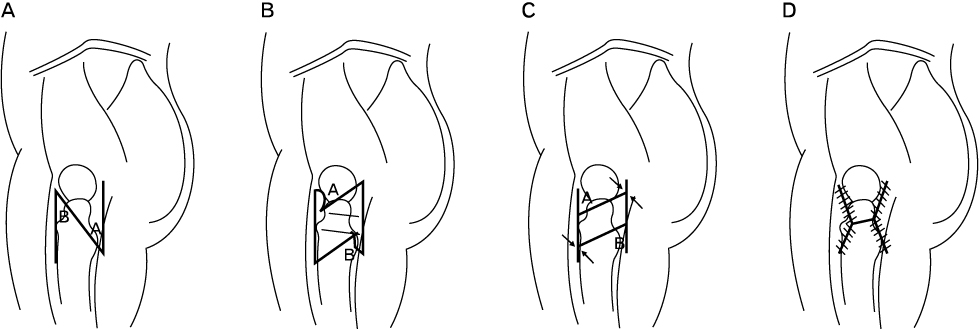Korean J Sports Med.
2012 Dec;30(2):144-147. 10.5763/kjsm.2012.30.2.144.
Surgical Treatment of Snapping Hip by Modified Z-plasty of the Iliotibial Band
- Affiliations
-
- 1Department of Orthopedic Surgery, National Police Hospital, Seoul, Korea. swkim@nph.go.kr
- KMID: 2288605
- DOI: http://doi.org/10.5763/kjsm.2012.30.2.144
Abstract
- We performed modified Z-plasty (N-plasty) in the patients with snapping hip syndrome arising from the iliotibial band whose pain and clicking sensation persisted despite conservative treatments. We analyzed clinical results to evaluate the effectiveness of this new technique. Among 51 patients (65 cases) who still felt pain and reported clicking sensation during daily life despite hospitalization for at least 2 months from January 1999 to November 2011, we evaluated a total of 32 patients (37 cases) who underwent N-plasty and followed up for more than 6 months. All patients were male whose average age was 24 years. Initial symptoms developed an average of 10 months before hospital visit. Surgery was defined success by postoperative 6 months at which time the patient could be able to carry on with daily life and to exercise without clicking sensation and pain, and defined failure when either clicking sensation or pain was present. We observed that the posterior portion of the iliotibial band was thickened by an average of 8.4 mm. Tenotomy of the iliotibial band lengthened the band by an average of 23mm and narrowed the width of the iliotibial band anterior to posterior. Success was in 33 cases (89%) after surgery. Failure was observed in 4 cases. Three were improved after resurgery and 1 was treated conservatively. We found that N-plasty performed in external type snapping hip patients was an effective method yielding a high success rate.
Keyword
Figure
Cited by 1 articles
-
External Snapping Hip Treated by Effective Designed N-plasty of the Iliotibial Band
Jong-Seok Park, Woo-Jong Kim, Dhong-Won Lee, Jae-Wan Soh, Sung-hun Won, Sang-Woo Lee, Sang-Il Moon, Hyoung-Ye Kim
Hip Pelvis. 2017;29(3):187-193. doi: 10.5371/hp.2017.29.3.187.
Reference
-
1. Clancy WG. Runners' injuries. Part two. Evaluation and treatment of specific injuries. Am J Sports Med. 1980. 8:287–289.2. Jacobs M, Young R. Snapping hip phenomenon among dancers. Am Correct Ther J. 1978. 32:92–98.3. Schaberg JE, Harper MC, Allen WC. The snapping hip syndrome. Am J Sports Med. 1984. 12:361–365.4. Asai H, Toennis D. Die vertaengerung des tractus iliotibialis zur behandlung der schnappenden huefte. Orthop Praxis. 1979. 115:128–130.5. Brignall CG, Brown RM, Stainsby GD. Fibrosis of the gluteus maximus as a cause of snapping hip. A case report. J Bone Joint Surg Am. 1993. 75:909–910.6. Brignall CG, Stainsby GD. The snapping hip. Treatment by Z-plasty. J Bone Joint Surg Br. 1991. 73:253–254.7. Satku K, Chia J, Kumar VP. Snapping hip: an unusual cause. J Bone Joint Surg Br. 1990. 72:150–151.8. Larsen E, Gebuhr P. Snapping hip after total hip replacement. A report of four cases. J Bone Joint Surg Am. 1988. 70:919–920.9. Zoltan DJ, Clancy WG Jr, Keene JS. A new operative approach to snapping hip and refractory trochanteric bursitis in athletes. Am J Sports Med. 1986. 14:201–204.10. Larsen E, Johansen J. Snapping hip. Acta Orthop Scand. 1986. 57:168–170.11. Fery A, Sommelet J. The snapping hip. Late results of 24 surgical cases. Int Orthop. 1988. 12:277–282.12. Dederich R. The snapping hip. Enlargement of the iliotibial tract by Z-plasty. Z Orthop Ihre Grenzgeb. 1983. 121:168–170.13. Ekman EF, Pope T, Martin DF, Curl WW. Magnetic resonance imaging of iliotibial band syndrome. Am J Sports Med. 1994. 22:851–854.
- Full Text Links
- Actions
-
Cited
- CITED
-
- Close
- Share
- Similar articles
-
- The Surgical Treatment of External Snapping Hip by Modified Z-plasty (N-plasty) of the Iliotibial Band
- External Snapping Hip Treated by Effective Designed N-plasty of the Iliotibial Band
- External Snapping Hip Syndrome: Emphasis on the MR Imaging
- Arthroscopic Treatment for External Snapping Hip
- Snapping Knee caused by the Semitendinous Tendon: A Case Report


